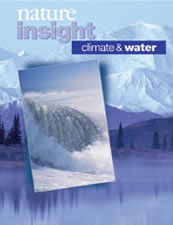Climate and
water
 |
Cover
illustration |
Vol. 419, No. 6903
(12 September 2002).
|![]() PDF
PDF![]() (87
(87![]() K)
K)![]() |
|
The book of Genesis, one of the oldest written accounts of human thought about nature, places water second in importance only to light. In the story of the creation, day 2 already is devoted to the separation of the waters below the sky from the waters above it; day 3 begins with the separation of land from oceans.
As recognized since the writing of the Old Testament, the distribution of water within the Earth system is vitally important for humankind and life in general. Of the two most important climate parameters, temperature and precipitation, the latter simply is water and the former is dominated by water in its role of distributing heat over the planet.
A large number of feedback cycles, some of them opposite in effect to others, are involved in this distribution of the incoming energy from the Sun. Water vapour in the atmosphere is the most important greenhouse gas, but clouds and ice sheets can cool the Earth by reflecting energy back to space. Ocean currents transport heat away from the tropics and release it in high latitudes, but they also bring moisture which — under suitable conditions — can induce the growth of ice sheets. Boldly simplified, water acts as the venetian blind of our planet, as its central heating system and as the fridge, all at the same time.
How the balance between the multitude of processes will evolve in a changing climate is as important a question as it is difficult. Water in its various forms has always worked as a great amplifier of changes, such as variations in insolation or tectonic changes, that are imposed on the climate system. Similarly, water is intimately involved in the way the more recent addition of anthropogenic greenhouse gases affects climate.
The articles in this Insight explore some of these interactions between climate and the hydrologic cycle in the past, present and future.
Heike Langenberg Senior Editor
| Reducing
uncertainty about carbon dioxide as a climate driver LEE R. KUMP doi:10.1038/nature01087
| 188 | ||
| The
hydrologic cycle in deep-time climate problems RAYMOND T. PIERREHUMBERT doi:10.1038/nature01088
| 191 | ||
| Links
between climate and sea levels for the past three million years KURT LAMBECK, TEZER M. ESAT & EMMA-KATE POTTER doi:10.1038/nature01089
| 199 | ||
| Ocean
circulation and climate during the past 120,000 years STEFAN RAHMSTORF doi:10.1038/nature01090
| 207 | ||
| A
satellite view of aerosols in the climate system YORAM J. KAUFMAN, DIDIER TANRÉ & OLIVIER BOUCHER doi:10.1038/nature01091
| 215 | ||
| Constraints
on future changes in climate and the hydrologic cycle MYLES R. ALLEN AND WILLIAM J. INGRAM doi:10.1038/nature01092
| 224 | ||
| Towards
objective probabilistic climate forecasting (Box 1 from above article) MYLES R. ALLEN AND DAVID A. STAINFORTH doi:10.1038/nature01092
| 228 | ||